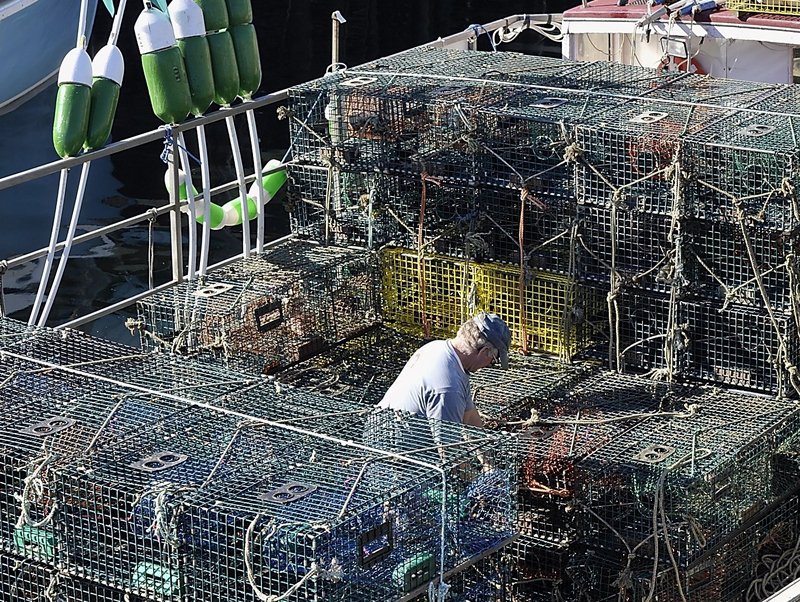ORONO – Maine lobster fishermen are turning to the labor movement via the International Association of Machinist and Aerospace Workers to protect and enhance their interests.
John Drouin, a Cutler lobsterman and vice chairman of the Maine Lobster Advisory Council noted that Maine lobstermen operate as independent business owners, compared with Canadian lobster fishermen, who are represented by unions and thus exert greater influence against the processors.
“Until the day comes when we become unionized or one big co-op, we are just 5,000 individuals,” Drouin said.
Justin Dyer, a Vinalhaven lobster fisherman sounded a similar theme: “We’ve never been organized. We need to be proactive in our own industry, and we haven’t been.”
Not so. Collective action is not foreign to the “toilers of the sea.” History reveals that romantic images generated by our souvenir and gift shops, which cast the lobster fishermen as an independent, sturdy, self-reliant species of workers, may be somewhat limiting.
A glance at the dusty archives of Maine labor history reveals that when they believe they were denied the full “fruits of their labor” (the lobster catch ), lobster fishermen could become militant, engage in collective action, and shatter such stereotypical images of their life and work.
Archival fragments shout out that the Maine lobster fishermen made a major contribution to the American labor movement when they organized the Lobster Fishermen’s International Protective Association, American Federation of Labor in 1907, “the first of its kind in the history of the labor movement.”
Control over their work lives, always subject to the whims of nature, was increasingly challenged by changing economic circumstances at the turn of the century.
Under market conditions in which many buyers competed for their catch, lobster fishermen lacked an incentive for united action. Demand for lobsters was fairly constant and many fishermen were not obligated to sell their lobsters from day to day, as the lobsters could live for several hours out of water, or, when placed in the water, kept for weeks or months.
But this idyllic competitive market condition would change, reflecting the economic transformation sweeping across the nation. By 1904, one or two large firms, generally brought together by merger, controlled at least half the output in 78 different industries.
he advantageous market position of the lobster fishermen was altered by a growing concentration of buyers — “the lobster trusts” — who sought to control the price they paid for the crustacean.
An advocate for labor organization described the new economic realities: “These fishermen never realized the necessity of their organizing, because the buyers were generally in competition, and the highest bidder got the catch. But the time came when there was a rumor of a combine to control the whole business: The buyers were all to agree only to buy a stipulated sum, and it began to look as if the fishermen were ‘up against it,’ the remedy was in their own hands. Organize! was the slogan. . . .”
Along with the concentration of buyers, lobster fishermen were increasingly challenged by a declining lobster population. Early legislative efforts to regulate the catch and sale of the small lobsters proved ineffective, as lobster-catchers regarded such legislation, and the fish warden assigned to enforce it, as interference with the “natural rights of fishermen.”
Vinalhaven fishermen launched the crusade to protect themselves and the “toothsome crustacea,” and organized the first union of lobster fishermen on Feb. 22, 1905. The movement quickly spread up and down the whole coast, hoping to win over the estimated 18,000 lobster catchers.
“This is one industry that cannot be successfully ‘trustified’ shouted a militant lobster fisherman.
National organizers joined in the labor organizing crusade and, in what was a first in labor union history, took a nautical turn as they hired a 36-foot sloop with AFL emblazoned on its sails to organize lobster fishermen along the coast and Nova Scotia.
On January 22, 1907, a charter was issued to the lobster fishermen as an affiliated international union and By the fall of 1907, the new union reported 1,055 members and 22 locals.
Counted among the achievements of the embryonic union was its success in bargaining with local buyers and with “smacks,” usually steamers sent out by wholesale dealers from Portland, Rockland and elsewhere, which were able to store between 3,000 and 10,000 lobsters in their wells. Some of the steamers were persuaded to fly the union flag and to handle nothing but union lobsters.
In 1931, lobster fishermen renewed efforts at unionization. Yet again, in 1954, they organized the Maine Lobstermen’s Association to exert a measure of control over their labor, only to discover they collided with the nation’s Sherman Anti-Trust law.
In recent years, tie up of their lobster boats in protest served as a strong statement of their reservoir of anger and militancy.
Today, they are once again reuniting with their militant tradition to protect and enhance their interests via the labor movement.
Charles Scontras of Cape Elizabeth is a historian and research associate at the Bureau of Labor Education of the University of Maine.
Send questions/comments to the editors.



Success. Please wait for the page to reload. If the page does not reload within 5 seconds, please refresh the page.
Enter your email and password to access comments.
Hi, to comment on stories you must . This profile is in addition to your subscription and website login.
Already have a commenting profile? .
Invalid username/password.
Please check your email to confirm and complete your registration.
Only subscribers are eligible to post comments. Please subscribe or login first for digital access. Here’s why.
Use the form below to reset your password. When you've submitted your account email, we will send an email with a reset code.